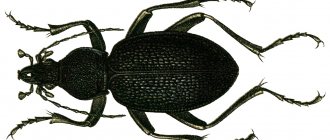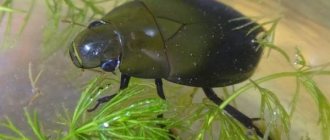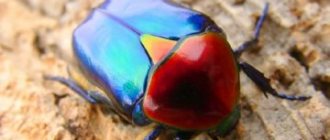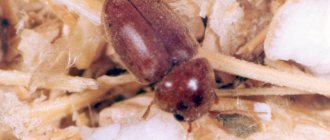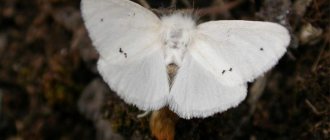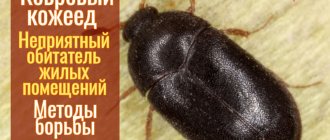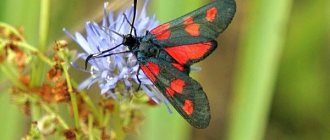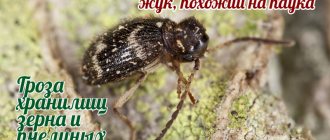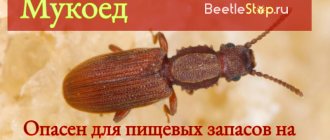A common and numerous species of insect is the ground beetle. It inhabits all geographical zones due to its ecological plasticity. There are more than 50,000 species in the world - representatives of this family, of which about 3,000 species are found in Russia. There is debate among people regarding the practical significance of ground beetles: some believe that this beetle is a pest of garden crops and cereals, others classify the species as beneficial insects that destroy caterpillars, snails and slugs. To find the answer to the question, you will need to consider what types of ground beetles are found in our country.
Ground beetle photo
The family includes many species and genera that differ little from each other. To diagnose beetles, it is necessary to take into account many nuances - from the color and shape of the insect to the structure of the genitals.
The ground beetle, which lives in Russia, in the photo most often has an elongated body shape up to 8 cm long. The wings of the insect are not intended for flight. Beetles move through the air only for settlement, but their main means of transportation is fast, long legs. Some members of the family lack wings.
Ground beetle description
The ground beetle is a representative of beetles with a large number of species and genera; the description can be presented in the form of characteristic features:
- dark color with a metallic tint;
- segmented body shape;
- transverse lines on a black background creating a rainbow effect;
- body shape from round to elongated, stem-like;
- body sizes from 1 mm to 10 cm;
- long and thin limbs for fast movement;
- wings with caraboid venation;
- hard elytra completely cover the abdomen.
To identify a specific type of ground beetle, it is necessary to take into account the smallest nuances of the structure of the limbs and jaw apparatus, color and body size.
Classification and habitat
Entomologists say: an insect such as the ground beetle has a huge number of genera and species, which makes them difficult to distinguish. To be able to accurately determine the species, scientists decided to classify them by:
- coloring;
- body shape;
- surface structure;
- external structure;
- sizes;
- structure of the genitals.
Insects have a variety of colors, with a predominance of dark tones and metallic shades. Individual individuals are distinguished by a special body shape, which is characteristic of a certain subfamily of ground beetles.
Ground beetles that live on the beach have a round shape, while those that live in grass or flowers have an elongated, stem-like shape. Species that live in caves visually resemble ants, as they have a convex structure and a huge head.
Most of these insects live where the soil is moist. They choose an area with a relatively low temperature. Phytophages can live in places with insufficient humidity, since they are able to compensate for it with plant tissues. The same applies to parasitoids; they are still able to withstand high temperatures.
Some species are found in places with strong salinity (salt marsh, salt lake). Their large numbers help them inhabit all latitudes - from the tropics and deserts to the cold tundra.
What does a ground beetle eat?
Depending on what the ground beetle eats, its practical significance is determined. Based on this parameter, the following categories are distinguished:
- Phytophages are a small number of species that destroy cultivated plants.
- Entomophages are predatory members of the family whose victims are earthworms, slugs, insect larvae and snails.
- Mixophages are ground beetles with a mixed type of diet. They use plant and animal objects as food.
The second group of insects is useful and helps to destroy pests of cultivated plants.
Nutrition
The ground beetle lives in forests, parks, gardens and personal plots, where there is a large accumulation of all kinds of food. The favorite “dishes” of beetles were and remain:
- caterpillars;
- larvae;
- aphid;
- slugs;
- snails
The principle of hunting and capturing prey is extremely simple. When a beetle discovers its “dinner,” a special fluid is activated in the glands hidden in its powerful jaws. The beetle sprays its victim with this composition, waits a few minutes and then begins to eat.
The injected composition immobilizes the insect and softens it into a kind of pulp, which the beetle easily absorbs. After a hearty lunch, the ground beetle can return to its shelter and not come out for several days in a row to digest the food. After complete digestion, after two or three days, the beetle goes hunting again.
Some species, such as amara and ophorus, prefer exclusively plant foods. Their diet includes leaves and soft parts of plants. Such beetles can harm crop plants.
Where does the ground beetle live?
Soil moisture is the main factor influencing the development of ground beetles. They prefer places with high humidity and low temperatures. The main places where ground beetles live are soil, bushes and trees.
Environmental conditions have a strong influence on population size. In dry autumn and summer, the number of offspring decreases sharply.
Pest beetles can enter a person's home and destroy food. They are often found in cereals, flour, and sugar. They enter homes through open windows and doors, with street debris and wood, and multiply in old frames and furniture.
Reproduction method
Common ground beetles mate in late summer or early autumn. In this species, weather is of great importance for procreation. During this period it is optimal. If there is a dry year, the number of eggs laid by the female decreases sharply. The offspring are placed underground, approximately 10 cm from its surface. There is an incubation period (2–3 weeks), after which the larvae appear.
Ground beetle larvae
Initially the larvae are grayish-white in color. In this form they wait out the cold deep underground. As soon as the frosts go away, the larvae rise to the upper layers of the soil and begin to feed intensively. This process can last from 3 to 5 weeks. Gradually, due to the eaten greenery, the larvae change color to dirty green, and sometimes even black. Around mid-spring, pupae appear in their place.
Ground beetle larva
The lifespan of a ground beetle is about 3 years. In the process of development from egg to adult, it passes through two intermediate stages - pupa and larva.
Females lay clutches in fertile soil, the number of oval smooth eggs in which can reach 250 pieces. Larvae appear on the 14th day. They are white in color and have 3 pairs of claw-like limbs. After 10 hours, the body of the larvae acquires a black color with a purple tint, and on the second day they form powerful jaws. The ground beetle larva pupates at the end of spring and turns into an adult sexually mature individual.
Why is it dangerous for plants in the country house and in the apartment?
Herbivorous ground beetles cause damage to many plants, it all depends on the type of beetle. The harvest is destroyed not only by adults, but also by larvae. This applies to bread beetles and hairy ground beetles. It is these 2 species that are dangerous for plants in the country house and in the apartment. Unlike ordinary ground beetles, these eat not garden pests, but plants. Adult beetles gnaw the ear, the grain falls to the ground, then they eat it. In half a month, one adult beetle is capable of destroying from 30 to 40 grains.
In an apartment, ground beetles are attracted to the food left on the table, as well as various cereals. Some bugs may enter your home based on the smell of pet food.
Ground beetle harm
Is the ground beetle harmful to crops, and is it dangerous to humans? The practical importance of insects is determined by their lifestyle and type of nutrition. The main damage to cultivated plants is caused by phytophagous ground beetles:
- The bread ground beetle is an individual with a pitch-black color and a body length of up to 1.5 cm. The insect feeds on cereals, young leaves of winter varieties, pollen and nectar, and causes significant damage to agricultural farms.
- Ground beetle larvae prefer the juice of young seeds in rye, wheat and barley fields. They also feed on leeks, oats and corn.
A well-known representative of the mixed type of feeding is the millet ground beetle.
In conditions of abundant green spaces, the insect turns into a phytophage; in the absence of plants, it becomes an entomophage. On the territory of Russia you can find useful entomophagous ground beetles. The most numerous species is the common ground beetle (garden beetle). Distinctive features:
- long mustache;
- body up to 3 cm long with a brown or dark graphite color and a metallic sheen;
- golden inclusions on oblong grooves in the flap area;
- powerful sickle-shaped jaws for holding prey;
- developed strong limbs for quickly moving and pursuing prey.
Garden ground beetles are classified as beneficial insects with a nocturnal lifestyle.
Its bite with powerful jaws is able to cope with the chitinous cover of any insect. The adult feeds on caterpillar larvae, beetles, snails, slugs and other insects that destroy cultural plantings. During the season, one ground beetle eats more than 1000 pests of garden plants. The population of beneficial insects is declining every year. The main reasons are the destructive effects of pesticides and increased interest in beetles from collectors and tourists. To maintain a high population of garden ground beetles, the following recommendations should be followed:
- protect the garden plot from shrews, birds of prey, moles and other animals that eat beneficial beetles;
- carefully select chemicals to protect plants from pests.
By destroying ground beetles and other pests with pesticides, people often reduce the population of beneficial beetles. To prevent such consequences, it is better to entrust the choice of control method to qualified specialists. Workers will select the optimal product to get rid of pests of cultivated plants and quickly treat the area using professional equipment.
Natural enemies
The ground beetle has a lot of enemies in its natural environment. All of them can be divided into two groups: parasites and predators.
Parasites include fungi that live on eggs, larvae and adult insects. By settling in the intestines or body (sometimes in the oral cavity) of ground beetles, parasites lead to the death of insects or their castration. Mites and nematodes also harm beetles. Ground beetle larvae can be used for breeding by wasps - ichneumon flies or flies - tahini.
But a much larger number of ground beetles die from the predators that hunt them. These include:
- Animals – foxes, badgers, moles, hedgehogs, bats and shrews;
- Birds are representatives of the order passerines and owls;
- Amphibians – toads and frogs;
- Insects - spiders, ants and beetles - rove beetles.
But, as a rule, a healthy balance of the natural environment does not allow predators to critically reduce the number of beneficial ground beetles. Unfortunately, humans are directly involved in their destruction.
Author of the article
Biologist, amateur entomologist. Experienced gardener and gardener.
Fighting ground beetles pests
The jaws and limbs will help you identify the beneficial ground beetle from the pest beetle. In predators they are much more powerful and longer. The bread ground beetle's legs are short, and its body is almost completely black.
To effectively protect fields from grain ground beetles, it is recommended to harvest crops early and in a short time. Removing straw from fields, peeling stubble, plowing the soil in the fall has a beneficial effect on reducing the insect population.
To destroy the larvae, you can treat plant seeds with pesticides, and during grain formation - with insecticides.
To get rid of ground beetles in your garden, experts advise following the following rules:
- plant grain crops on the site no more than once every 2 years;
- promptly treat plantings with pesticides that have a detrimental effect on beetle larvae;
- During the growth period of grain crops, use chemicals that protect grain and plant leaves from adult insects.
If you find a ground beetle at home, you must immediately begin fighting the insects.
If an adult has already laid a clutch of eggs, it will be much more difficult to destroy the population. The following measures will help in the fight against ground beetles that have settled in the house:
- determining the location where insects accumulate, thoroughly treating the area;
- timely clearing of food from the table, disposal of garbage;
- cleaning kitchen surfaces with chemicals or a solution based on soda or acetic acid.
One of the unpleasant consequences of having beetles in the house is the spoilage of bulk products. To kill insects, the destructive effects of temperature and UV rays are used:
- the cereal is kept in the oven at a temperature of more than 100 degrees for 30 minutes;
- bulk food is left in the sun for several hours;
- The container with the cereal is placed in the freezer for several hours.
It is not recommended to use such products for food.
The best option is to get rid of grains and flour with beetles, and treat kitchen cabinets with a vinegar solution. Plants with a strong aroma - mint, lavender, wormwood - will help to avoid the reappearance of insects in the house. They can be placed on kitchen shelves and in cabinets. If your garden plot or house is attacked by ground beetles or other parasitic insects, seek help from specialists. They will analyze the situation and select the appropriate professional pest control method. For consultation, contact a company representative by phone.
Calculator
Security status
The number of shagreen ground beetles is declining in all habitats. Several factors contribute to the decline of the species:
- Deforestation, which is a natural biotype of beetles.
- Recreational loads in habitats.
- Lack of wings and weak migratory ability of beetles.
- Treatment of forests with chemicals.
The shagreen ground beetle is listed in the Red Book of the Chuvash Republic, Belarus, Lithuania, and the Smolensk region of the Russian Federation. To preserve the species, it is necessary to prohibit collecting insects, reconstruct parks and forests in beetle habitats, and reduce recreational use.

